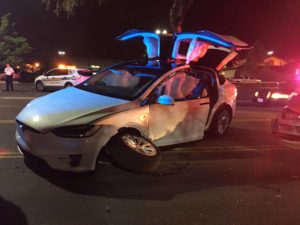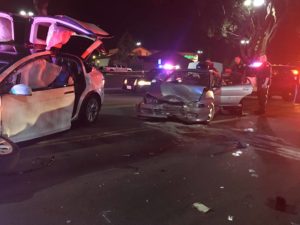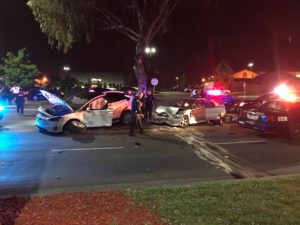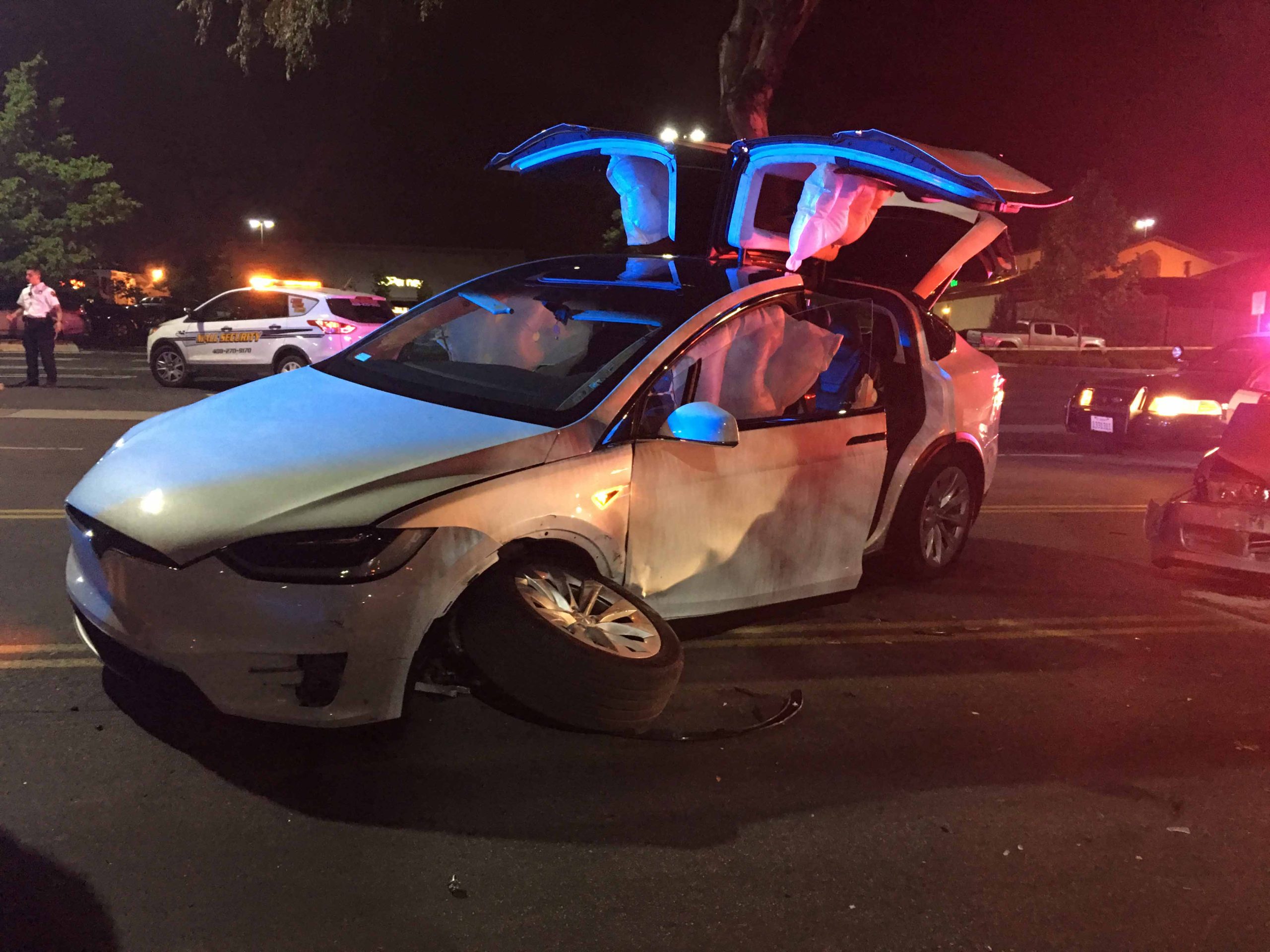
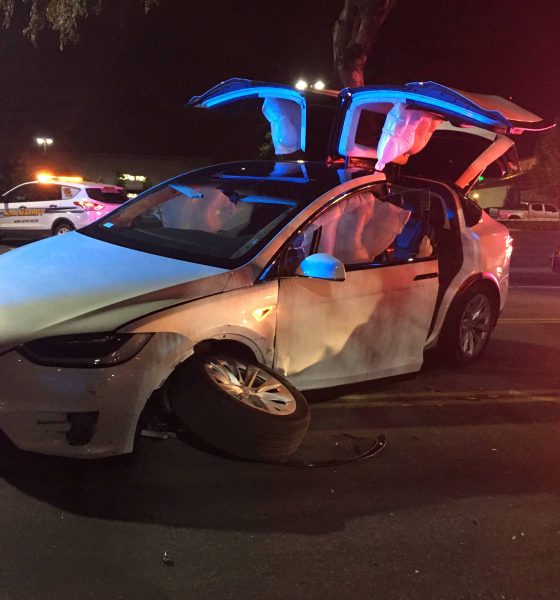
News
Tesla Model X safety-first approach saves groom’s life after hit and run the night before his wedding
A groom-to-be behind the wheel of Tesla Model X is thankful to be alive after the vehicle was involved in a severe side-impact collision by a stolen vehicle that careened into the driver’s door of the all-electric SUV at 65 miles per hour.
The driver, an automation consultant for Tesla, rented a Model X for his wedding. After leaving the rehearsal dinner that took place the night before the wedding, the groom-to-be dropped off his fiancé and headed home. Then things took a turn for the unexpected. In a forum post entitled ‘I am alive today well BC of a Model X‘, the driver recounts:
“When I made my way out of the parking lot, I began to take a left turn onto the main street. Mid-turn, I noticed a silver car quickly approaching the driver’s side of the vehicle (I later learned that they were going over 65mph on a private road). I had no time to react, since the driver came from a blind spot on my left. At this point, it looked like the driver had no intention of slowing down, and I immediately thought that I was either going to get badly hurt or potentially die.
I quickly braced and gripped the steering wheel as I was pounded by the silver car, sending me over 20 feet away from my starting point. With the impact, all of the airbags deployed, instantly leaving me in shock. The outgassing of the airbags caused the car to smoke, making it difficult to see. I reached for the door handle with my right hand, but was not able to open it. Seeing no other option, I kicked open the door and was able to escape the vehicle. As I walked outside, I immediately saw the police chasing after the culprits driving the silver car. I looked around, dazed, and ended up falling to the ground. I am unsure of what happened next, but all I can remember is hearing voices from the people nearby, and Nancy screaming my name. When I came to consciousness, I was being helped by the police, paramedics, and fire department. The silver car was a mess, but the Model X only suffered a broken axle and bent wheel.”
An impact from a 3,000 pound Honda Civic traveling at 65 miles per hour into a nearly stationary vehicle would normally end with disastrous consequences but the Model X was able to sustain the impact by cocooning the driver with twelve airbags: head and knee airbags in the front, two side curtain airbags, four seat-mounted side airbags, and two door-mounted airbags, putting the safety-first design to the test in ways nobody would ever want to have to experience. We saw a similar occurrence last year when a Tesla Model X saved the life of an entire family and their pet after it was involved in a horrific traffic accident at an intersection. “I waited 4 years for this one and would wait 4 more if that is what it took to protect my family like this.” said the driver of the Model X at the time.
The groom-to-be that was saved in this latest accident had previously worked with Tesla as an automation consultant for the company in the stamping, body and paint production line, and worked directly with engineers involved in the Model S, X and Model 3. Having worked with many of the people who designed the vehicle instilled a respect for Tesla and its vehicles that was enough for him to choose a Model X as the vehicle to be used for his wedding.
“I wanted to write this to you in hopes that this raises visibility to the management chain at Tesla. I can’t thank Elon Musk, Tesla, and the team enough for what they do and want them to know that their car saved my life. While I also believe that I am still alive because of divine intervention, being in that car was definitely my shield and protector. I have made it a short term goal of mine to sell my cars and buy a Tesla as my next vehicle. That car saved my life. Thank you for your time and I hope this message gets passed through to everyone, especially Elon.”
This story highlights a critical differentiator between Tesla and other auto manufacturers. Tesla and Elon Musk have always put safety first which the company puts as a main focal point at each new vehicle reveal. This focus on safety led to the development of vehicles with larger crumple zones up front (the frunk) than any comparably-sized vehicle, better coverage from integrated airbags and a greatly reduced risk of rollover due to the floor-mounted battery.
Tesla summarizes the safety features of the Model X on its website:
Model X is designed with safety as the first priority. The floor-mounted battery lowers the center of gravity so that the risk of rollover is about half that of any vehicle in its class. The battery structure strengthens Model X against side impact intrusions. And without a gasoline engine, the large front trunk acts as a giant impact-absorbing crumple zone. Although the National Highway Traffic Safety Administration has not yet conducted crash testing on Model X, Tesla’s own internally conducted crash testing indicates that Model X should be the first SUV to receive the highest safety rating in every category.
Building on the world-class safe design of Tesla vehicles, a layer of active safety features that are included in every Tesla sold take this to the next level with features like Automatic Emergency Braking and side impact collision warnings.
The safety-first culture at Tesla extends beyond its vehicles and into the next generation of products the company is producing – its factory. In its recent blog post about safety, Tesla shared how a safety-first focus underpins the entire design process even going so far as to look for ergonomics concerns in virtual mock ups of its manufacturing lines before they are built.
Tesla is revolutionizing the way humans get around and at the same time, rethinking the safety systems that keep all the people in its care in ways that ultimately benefit everyone. The driver of the Model X in this accident has made it a short term goal to acquire a Tesla as his personal vehicle. That should speak volumes to anyone who has been in an accident, lost someone in an accident or wants to keep themselves and those they travel with as safe as possible.
Source: Teslarati Forums

Elon Musk
Elon Musk and Tesla AI Director share insights after empty driver seat Robotaxi rides
The executives’ unoccupied tests hint at the rapid progress of Tesla’s unsupervised Robotaxi efforts.

Tesla CEO Elon Musk and AI Director Ashok Elluswamy celebrated Christmas Eve by sharing personal experiences with Robotaxi vehicles that had no safety monitor or occupant in the driver’s seat. Musk described the system’s “perfect driving” around Austin, while Elluswamy posted video from the back seat, calling it “an amazing experience.”
The executives’ unoccupied tests hint at the rapid progress of Tesla’s unsupervised Robotaxi efforts.
Elon and Ashok’s firsthand Robotaxi insights
Prior to Musk and the Tesla AI Director’s posts, sightings of unmanned Teslas navigating public roads were widely shared on social media. One such vehicle was spotted in Austin, Texas, which Elon Musk acknowleged by stating that “Testing is underway with no occupants in the car.”
Based on his Christmas Eve post, Musk seemed to have tested an unmanned Tesla himself. “A Tesla with no safety monitor in the car and me sitting in the passenger seat took me all around Austin on Sunday with perfect driving,” Musk wrote in his post.
Elluswamy responded with a 2-minute video showing himself in the rear of an unmanned Tesla. The video featured the vehicle’s empty front seats, as well as its smooth handling through real-world traffic. He captioned his video with the words, “It’s an amazing experience!”
Towards Unsupervised operations
During an xAI Hackathon earlier this month, Elon Musk mentioned that Tesla owed be removing Safety Monitors from its Robotaxis in Austin in just three weeks. “Unsupervised is pretty much solved at this point. So there will be Tesla Robotaxis operating in Austin with no one in them. Not even anyone in the passenger seat in about three weeks,” he said. Musk echoed similar estimates at the 2025 Annual Shareholder Meeting and the Q3 2025 earnings call.
Considering the insights that were posted Musk and Elluswamy, it does appear that Tesla is working hard towards operating its Robotaxis with no safety monitors. This is quite impressive considering that the service was launched just earlier this year.
Elon Musk
Starlink passes 9 million active customers just weeks after hitting 8 million
The milestone highlights the accelerating growth of Starlink, which has now been adding over 20,000 new users per day.

SpaceX’s Starlink satellite internet service has continued its rapid global expansion, surpassing 9 million active customers just weeks after crossing the 8 million mark.
The milestone highlights the accelerating growth of Starlink, which has now been adding over 20,000 new users per day.
9 million customers
In a post on X, SpaceX stated that Starlink now serves over 9 million active users across 155 countries, territories, and markets. The company reached 8 million customers in early November, meaning it added roughly 1 million subscribers in under seven weeks, or about 21,275 new users on average per day.
“Starlink is connecting more than 9M active customers with high-speed internet across 155 countries, territories, and many other markets,” Starlink wrote in a post on its official X account. SpaceX President Gwynne Shotwell also celebrated the milestone on X. “A huge thank you to all of our customers and congrats to the Starlink team for such an incredible product,” she wrote.
That growth rate reflects both rising demand for broadband in underserved regions and Starlink’s expanding satellite constellation, which now includes more than 9,000 low-Earth-orbit satellites designed to deliver high-speed, low-latency internet worldwide.
Starlink’s momentum
Starlink’s momentum has been building up. SpaceX reported 4.6 million Starlink customers in December 2024, followed by 7 million by August 2025, and 8 million customers in November. Independent data also suggests Starlink usage is rising sharply, with Cloudflare reporting that global web traffic from Starlink users more than doubled in 2025, as noted in an Insider report.
Starlink’s momentum is increasingly tied to SpaceX’s broader financial outlook. Elon Musk has said the satellite network is “by far” the company’s largest revenue driver, and reports suggest SpaceX may be positioning itself for an initial public offering as soon as next year, with valuations estimated as high as $1.5 trillion. Musk has also suggested in the past that Starlink could have its own IPO in the future.
News
NVIDIA Director of Robotics: Tesla FSD v14 is the first AI to pass the “Physical Turing Test”
After testing FSD v14, Fan stated that his experience with FSD felt magical at first, but it soon started to feel like a routine.

NVIDIA Director of Robotics Jim Fan has praised Tesla’s Full Self-Driving (Supervised) v14 as the first AI to pass what he described as a “Physical Turing Test.”
After testing FSD v14, Fan stated that his experience with FSD felt magical at first, but it soon started to feel like a routine. And just like smartphones today, removing it now would “actively hurt.”
Jim Fan’s hands-on FSD v14 impressions
Fan, a leading researcher in embodied AI who is currently solving Physical AI at NVIDIA and spearheading the company’s Project GR00T initiative, noted that he actually was late to the Tesla game. He was, however, one of the first to try out FSD v14.
“I was very late to own a Tesla but among the earliest to try out FSD v14. It’s perhaps the first time I experience an AI that passes the Physical Turing Test: after a long day at work, you press a button, lay back, and couldn’t tell if a neural net or a human drove you home,” Fan wrote in a post on X.
Fan added: “Despite knowing exactly how robot learning works, I still find it magical watching the steering wheel turn by itself. First it feels surreal, next it becomes routine. Then, like the smartphone, taking it away actively hurts. This is how humanity gets rewired and glued to god-like technologies.”
The Physical Turing Test
The original Turing Test was conceived by Alan Turing in 1950, and it was aimed at determining if a machine could exhibit behavior that is equivalent to or indistinguishable from a human. By focusing on text-based conversations, the original Turing Test set a high bar for natural language processing and machine learning.
This test has been passed by today’s large language models. However, the capability to converse in a humanlike manner is a completely different challenge from performing real-world problem-solving or physical interactions. Thus, Fan introduced the Physical Turing Test, which challenges AI systems to demonstrate intelligence through physical actions.
Based on Fan’s comments, Tesla has demonstrated these intelligent physical actions with FSD v14. Elon Musk agreed with the NVIDIA executive, stating in a post on X that with FSD v14, “you can sense the sentience maturing.” Musk also praised Tesla AI, calling it the best “real-world AI” today.
